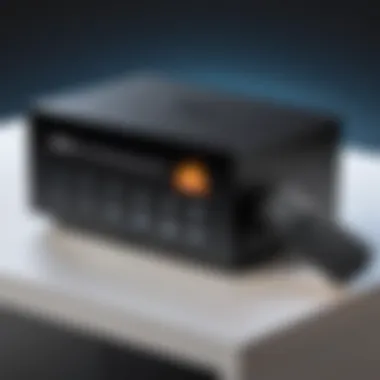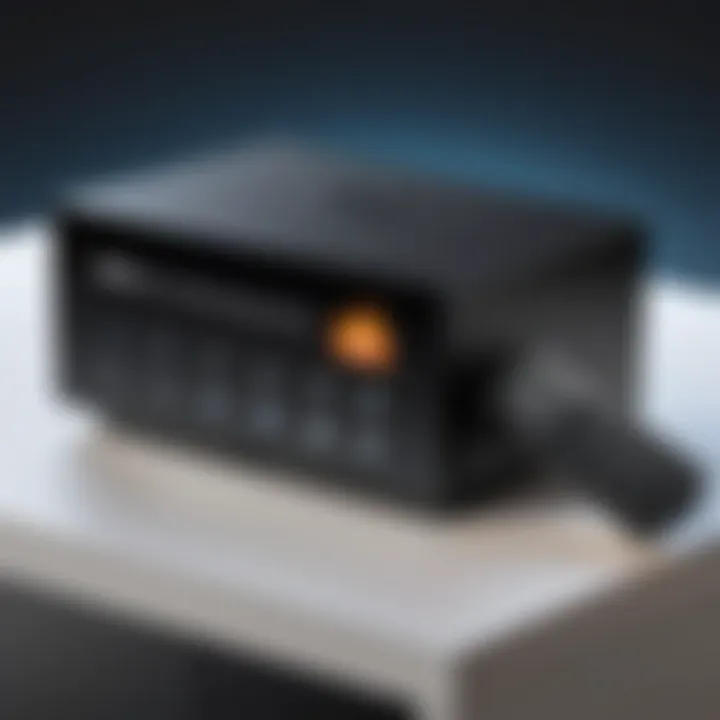Mastering Volume Control on the Fire TV App


Intro
Navigating the Fire TV app opens up a universe of entertainment, but managing volume can sometimes be a challenge. This guide is designed to provide readers with a thorough understanding of the volume management features available on the app. From basic adjustments to troubleshooting sound-related issues, we aim to enhance your viewing experience. Whether you are a novice user unfamiliar with the settings or a tech-savvy individual wanting to optimize audio control, this article will serve as a valuable resource.
Product Overview
The Fire TV app is a powerful tool that allows users to access a wide variety of streaming services right from their TV. Notable features include voice control, user-friendly interface, and compatibility with various audio devices.
A few key features you may find useful include:
- Volume control settings: Tailor the sound to your preference.
- Audio output options: Switch between TV speakers, soundbars, or external audio systems.
- Subtitles and captions: Useful for those who prefer text alongside audio.
The app is compatible with a range of devices such as Fire TV Stick and Fire TV Cube, making it a versatile choice for users seeking seamless entertainment.
Performance and User Experience
When testing the Fire TV app's performance, the volume control proved intuitive and responsive. Users can easily adjust settings via remote or the app interface. The layout is clean, allowing for quick access to features without hassle.
Its performance is commendable, enhancing user experience significantly compared to older models of streaming devices. However, users have reported occasional lags in volume adjustment when switching between different apps.
Overall, it stands out against competitors like Roku and Apple TV due to its extensive app library and integration capability.
Design and Build Quality
The design of the Fire TV app is modern and straightforward. The user interface emphasizes ease of navigation, allowing seamless transitions between various menus and features.
The app is built to be responsive, utilizing materials that optimize user interaction. Durability is also considered, with updates to ensure functionality over time.
Ergonomics is another focus area, ensuring that essential features are easily reachable and user-friendly for all ages.
Technology and Innovation
The Fire TV app leverages advanced technology to provide unique functionalities. Voice control, for instance, is a standout and allows users to manipulate sound levels without physically reaching for the remote.
Innovation also comes in the ability to connect various audio outputs, enhancing the overall experience dramatically for audiophiles. As sound technology evolves, the Fire TV app must adapt to remain competitive. Future updates are anticipated to bring even more robust audio features to this already impressive app.
Pricing and Value Proposition
Pricing for the Fire TV app is competitive compared to similar products in the market. It provides a cost-effective solution without compromising on quality. Users can expect reasonable subscription fees for additional services, making it accessible for most.
When comparing its value proposition against competitors, such as Google Chromecast or Nvidia Shield, many users find Fire TV offers superior organization and control of audio settings.
In summary, this comprehensive analysis reveals that the Fire TV app’s volume management is not only user-friendly but also packed with features that enhance the viewing experience. Understanding these features will allow users to maximize their entertainment options.
Understanding the Fire TV App
The Fire TV app serves as a pivotal gateway to a diverse world of entertainment, allowing users to access multiple streaming services and content types seamlessly. Understanding its functionalities is essential, as it directly influences user experience while enjoying various media. The app integrates various features that enhance usability, making it crucial for both novices and experts.
Being familiar with the Fire TV app helps users navigate their entertainment options more efficiently. It promotes a better understanding of how to manage volume settings effectively, which is a core focus of this guide.
In a crowded market of media consumption devices, the Fire TV app stands out because of its distinct capabilities. Users benefit from an intuitive interface, customizable settings, and robust compatibility with various audio and visual devices. Knowing these elements can greatly improve one’s overall viewing experience.
Foreword to Fire TV
Fire TV is Amazon's streaming media platform designed to bring content from the internet and various apps into the living room. Initially launched in 2014, it rapidly evolved to incorporate new features such as voice control compatibility and a diverse range of supported applications. Through the Fire TV app, users can stream content from sources like Netflix, Hulu, and Prime Video, among others.
The introduction of Fire TV has revolutionized how we consume television. It delivers content in high-definition and supports various audio formats, allowing users to enjoy rich, immersive experiences. Additionally, it often provides regular software updates that enhance functionality and introduce new features, keeping the device current and competitive.
Features of the Fire TV App


The Fire TV app encompasses a range of features that facilitate easy access to media and help manage settings, particularly volume control. Notable features include:
- User-Friendly Interface: The app is designed for intuitive navigation, making it easy to browse through content categories and access desired programming.
- Search Functionality: The powerful search function allows users to find content across multiple providers quickly. This can save time, especially when searching for specific shows or genres.
- Voice Control: Users can utilize Alexa to voice-command different actions, including searching for content or adjusting volume levels.
- Personalized Recommendations: Based on viewing habits, the app suggests new programs and movies, enhancing user engagement.
- Parental Controls: Fire TV app offers features that allow parents to restrict content access, ensuring a safe viewing environment for children.
Understanding these features is vital for optimizing the viewing experience and managing volume settings, which will be discussed in subsequent sections.
In summary, grasping the significance of the Fire TV app lays the foundation for making informed choices about volume management and enhancing overall media consumption. By recognizing its core elements, users can look forward to a more satisfying viewing journey.
Volume Control Options
The Volume Control Options available within the Fire TV app are essential for a seamless viewing experience. Proper volume management not only enhances clarity but also ensures that viewers can enjoy content without interruptions from sudden loud sounds or background noise. Given the rise of streaming services, understanding these options becomes more relevant. The user can fine-tune their audio settings according to different types of content like movies, music, or games, which is crucial for maximizing enjoyment.
Using the Fire TV Remote
The Fire TV remote is a fundamental tool for managing volume. Typically, it features dedicated buttons for volume up and volume down. Users can quickly adjust the volume without navigating through menus. An important aspect is the seamless integration of this feature, eliminating the need for multiple remotes. The remote also supports additional settings such as mute and unmute, which can be particularly useful during commercials or unwanted interruptions.
Additionally, many users appreciate how the remote connects automatically to the TV. First, ensure the Fire TV and your television set are paired correctly. If volume control does not respond, check the battery in your remote, as low power can affect performance.
Adjusting Volume through the App
Adjusting the volume through the app is another method that users should explore. This option may vary slightly depending on the device used to access the app. Users can find volume controls typically located on the screen during playback. It is usually represented by a speaker icon.
Using the app sometimes allows for more granular control. Here, users can tap on the speaker icon to bring up a slider for volume adjustment, making it easy to set levels just right for any particular show or movie. In the settings section of the app, there may also be options for audio enhancement, which may adjust the volume based on content type or personal preference. Therefore, tapping into the app's potential can lead to a more tailored experience.
Voice Control Features
Voice control represents a modern approach to volume management that many users find intuitive. When using devices equipped with Alexa, users can give voice commands to adjust the volume. Commands like "Alexa, turn up the volume" or "Alexa, mute the TV" instantly provide control, making it easier to manage while multitasking. This hands-free option is especially appealing for those who may have physical limitations or prefer convenience.
Furthermore, the voice control feature usually extends beyond simple volume commands. Users may access entertainment options through voice, combine tasks, or even request information related to ongoing shows. As a result, integrating voice control can significantly enhance the overall user experience.
"Effective volume control significantly enhances user satisfaction and overall enjoyment of content."
Adjusting Audio Settings
Adjusting audio settings is a crucial aspect when using the Fire TV app. It directly affects how the content is experienced. Optimal audio settings enhance clarity, balance sound levels, and make your viewing or listening experience more enjoyable. The Fire TV app offers various tools for users to customize their audio experience based on the content. This section will provide detailed insights into accessing these settings, optimizing audio for different types of content, and utilizing sound modes and effects effectively.
Accessing Audio Settings
To access the audio settings in the Fire TV app, follow these steps:
- From the home screen of the Fire TV, navigate to the Settings option.
- Select Display & Sounds.
- From there, choose Audio.
It is important to familiarize oneself with this process. Knowing where to find the audio settings allows for quicker adjustments to sound as needed. Also, exploring these settings can unveil features that might not be immediately obvious. For instance, there are options for adjusting the audio format, which can be vital for users with external audio systems.
Optimizing Audio for Different Content
Different types of media often require distinct audio settings. Movies might prioritize dialog clarity, while music apps may benefit from enhanced bass. The Fire TV app offers several modes that cater to specific content types. To optimize audio:
- For Movies and Shows: Use the dialog enhancer feature, if available, to ensure speech remains clear even during action-packed scenes.
- For Music Streaming: Increase bass settings to enrich the overall sound.
- For Gaming: Low-latency audio configurations may be necessary to get quicker feedback from the game.
By adjusting these settings according to content, you can significantly improve audio quality and enhance your overall experience on the Fire TV app.
Sound Modes and Effects
The Fire TV app includes various sound modes and effects that can be tailored to user preferences. Understanding these modes is key to maximizing audio performance. Some common modes include:
- Standard Mode: Typically balanced and suitable for most viewing.
- Cinema Mode: Enhances background scores and soundtracks, giving a more immersive experience for movies.
- Night Mode: Lowers the volume of loud noises while raising softer sounds, ideal for late-night viewing.
By experimenting with these modes, users can find the perfect fit for their unique viewing situation. Additionally, effects such as surround sound can also be adjusted. Be aware that some features may not function as intended without the appropriate sound system.
Common Volume Issues and Solutions


Addressing common volume issues is essential for enhancing the user experience on the Fire TV app. These issues can disrupt your viewing pleasure and lead to frustration. By understanding the prevalent problems and their solutions, users can ensure a smoother audio experience. Effective management of volume-related challenges can significantly improve the overall enjoyment of multimedia content.
Low Volume Issues
Low volume can be a concerning issue when using the Fire TV app. Many users find that the sound output is insufficient for their needs. This can stem from several factors. First, the audio settings on the Fire TV app may be configured poorly. Users should access the settings menu to check if the volume levels are set adequately.
Another reason might be that the app's audio output is compatible with the content being watched. For example, older television shows or movies may have lower audio production values. Ensure that your television's built-in speakers are not muted or set to a low level as well.
Here are steps to check and resolve low volume issues:
- Go to the Fire TV home screen.
- Navigate to Settings > Display & Sounds.
- Select Audio and adjust the volume level accordingly.
- Check individual app volume settings if available, as some apps may have their own controls.
Uneven Volume Levels
Experiencing uneven volume levels across different apps or shows can be frustrating. This inconsistency can arise from the audio processing used in various content. Some shows may use louder sound effects, while others rely more on dialogue, leading to noticeable volume fluctuations.
To minimize this issue, users can explore sound normalization options if their television or audio receiver supports it. Sound normalization helps maintain a consistent volume level. Additionally, it is wise to check the content format being streamed, as different formats may influence audio quality.
Consider these tips for managing uneven volume levels:
- Enable any available sound options in the app’s settings, such as volume limiting or dynamic range control.
- Adjust the audio settings on your TV to enhance dialogue clarity without sacrificing overall volume.
- Utilize soundbars or home theater systems that offer advanced processing features to balance audio output.
Audio Sync Problems
Audio sync problems occur when the sound does not match the visual cues on the screen. This issue can be particularly bothersome during critical scenes, detracting from the viewing experience. It can happen for various reasons, including network latency, app glitches, or compatibility issues between the Fire TV and connected devices.
To address audio sync issues, start by ensuring a good internet connection, as buffering can lead to delays. Restarting the app or the Fire TV device can also help resolve temporary glitches.
Here are some strategies to tackle audio sync concerns:
- Check for app updates that may fix glitches related to audio output.
- Try a different HDMI port on the television, as this can sometimes improve signal delivery between devices.
- If using external speakers or a soundbar, check the synchronization settings in their respective menus to adjust latency.
Remember: Routinely checking your audio settings and keeping the Fire TV app updated can prevent many volume-related issues from arising.
By being proactive and understanding these common issues, users can enhance their experience with the Fire TV app, ensuring a smooth and enjoyable audio-visual journey.
Connecting External Audio Devices
Connecting external audio devices is a crucial aspect of enhancing the auditory experience on the Fire TV app. Many users find that the in-built speakers of their televisions may not provide the same audio quality as dedicated audio equipment, such as Bluetooth speakers or soundbars. By exploring different connection options, users can achieve better sound fidelity, deeper bass, and overall improved audio clarity. Understanding how to seamlessly integrate these devices into the Fire TV ecosystem allows for a more enjoyable and immersive viewing experience.
Using Bluetooth Speakers
Bluetooth speakers offer a convenient and wireless solution for improving audio output on the Fire TV app. To connect a Bluetooth speaker, users must first enable pairing mode on the speaker and then navigate to the settings on the Fire TV. Within the settings, select the option for controllers and Bluetooth devices. When prompted, select the Bluetooth speaker from the list of available devices. This process is relatively simple and does not require any additional cables or complicated setups.
Benefits of using Bluetooth speakers include flexibility in placement and the ability to listen to audio away from the television. However, it is important to consider battery life and potential Bluetooth latency, which can result in sound delays during playback. To mitigate these issues, it is advisable to select high-quality speakers known for lower latency and extended battery performance.
Connecting Soundbars
Soundbars are another popular option for connecting external audio devices to the Fire TV app. They provide a more powerful audio experience compared to standard television speakers. To connect a soundbar, users typically have leverage of HDMI ARC or optical audio cables, depending on their soundbar and TV model.
For HDMI ARC, simply connect the soundbar to the TV's HDMI ARC port. This will allow for two-way communication, enabling the TV remote to control the soundbar's volume.
Alternatively, if using an optical cable, connect the soundbar's optical input to the TV’s optical output, then adjust the TV’s audio settings to ensure the optical output is activated.
The use of a soundbar enhances the clarity of dialogues and offers improved bass response, making it a suitable choice for cinematic experiences at home. However, it's essential to choose a soundbar compatible with Dolby and DTS technologies for optimal performance.
Wired Connection Options
Wired connections are often the most reliable when it comes to audio quality. Options like HDMI, optical, and even RCA cables provide stable and lag-free audio output. Users can connect their external audio devices directly to the Fire TV using these cables for consistent sound quality.
- HDMI: As mentioned before, using HDMI ARC allows not just audio but also other data signals between devices.
- Optical Cable: This is a digital connection that minimizes interference and maintains audio quality, suitable for systems that do not support HDMI.
- RCA Connections: Older devices might require RCA cables, usually color-coded red and white. Though they offer lower audio quality compared to HDMI or optical, they remain a practical solution for older systems.


Advanced Volume Management Techniques
Volume management on the Fire TV app is a critical aspect of enhancing the viewing experience. Properly adjusting volume settings can lead to a more immersive atmosphere, letting users appreciate sound quality tailored to their preferences. This section will discover advanced techniques that allow users to control volume not just in a basic way, but with so much more precision. By understanding the significance of these techniques, users can elevate their experience through optimized sound settings.
Setting Volume Levels per App
One benefit of navigating to setting volume levels per app is that it gives users granular control over their experience. Particularly in an environment where multiple applications are in use, discrepancies in app audio levels can lead to frustrating transitions. For instance, a streaming service might default to a lower volume while a game could be blasting at maximum.
To set volume levels per app, follow these steps:
- Open the Fire TV app.
- Go to your settings menu.
- Find the option for audio and volume settings.
- Select individual apps from the list.
- Adjust the volume slider accordingly.
This feature ultimately ensures that app-specific audio levels do not disturb the viewing experience.
Creating Custom Sound Profiles
Creating custom sound profiles is another advanced technique that can significantly enhance audio satisfaction. Different genres of shows, movies, or games may require different audio settings for optimal enjoyment. A custom sound profile can cater to these unique needs.
To create custom sound profiles, users can typically:
- Access the sound settings in the Fire TV app.
- Look for preset options or the ability to create a new profile.
- Adjust bass, treble, and overall volume based on preferences.
- Save the settings as a new profile.
- Name the profile for easy access later.
Custom sound profiles allow for seamless transitions between various content types without the need to constantly readjust settings. This function not only enhances the viewing experience but also simplifies user interaction by remembering preferred settings.
"Customizing your sound experience can truly make or break how you enjoy multimedia content. In today’s era of content abundance, sound should not be an afterthought, but a tailored experience."
Using these advanced techniques will give Fire TV users more control over their entertainment experience. With the ability to set volume levels for each app and create custom sound profiles, navigating audio settings evolves from a chore into a craft that elevates media consumption.
User Feedback on Volume Features
Understanding user feedback on volume features is essential for improving the experience on the Fire TV app. In a digital age where streaming is prevalent, users often share their experiences with sound management. This feedback holds significant value. It not only guides developers and designers in making improvements but also informs new users about the app's capabilities and limitations.
User feedback can pinpoint various aspects of volume control. Some might appreciate the intuitive nature of volume adjustments via the Fire TV remote or app interface. Others may highlight issues regarding audio sync problems or the necessity for additional sound modes. Consideration of this feedback helps in identifying common frustrations and areas needing enhancement. Overall, user input is a vital component that shapes the evolution of the app's audio management features.
User Reviews and Recommendations
Reviews from users provide insights into real-world applications of the Fire TV app's volume controls. For example, many users commend the straightforward design allowing easy volume adjustments. Such usability is crucial for enhancing the viewing experience, especially during moments of suspense or dialogue-heavy scenes where sound clarity is vital.
Additionally, recommendations often focus on integrating complementary devices. Users suggest that pairing the Fire TV app with high-quality soundbars or Bluetooth speakers can significantly elevate audio quality. They may also share tips for optimizing settings, ensuring tailored sound that fits their preferences.
However, critiques can also enlighten potential buyers. Some user reviews might express dissatisfaction regarding sound discrepancies when switching between different applications. Such observations can prompt developers to address these variances to create a more consistent experience.
Comparative Analysis with Other Streaming Devices
When contrasting the Fire TV app with other streaming devices, user feedback emerges as an important aspect. Devices like Roku or Apple TV have their differences in sound management. Users often highlight how sound modes on Apple TV enhance dynamic range in specific scenarios, while the Fire TV app is celebrated for its versatility and quick volume adjustments.
Evaluating these differences sheds light on areas where the Fire TV app excels and where it may fall short. For instance, while the simplicity of the Fire TV app is a plus, some may find the audio management options less robust compared to competitors. This analysis allows potential users to make informed decisions based on their sound preferences and viewing habits.
Ultimately, integrating user feedback on volume features aids in refining the app. The aim is to create an exceptional audio experience that meets diverse needs and continuously competes in the evolving streaming landscape.
Culmination and Final Thoughts
In exploring the nuances of managing volume on the Fire TV app, it becomes clear that effective audio control is essential for an optimal entertainment experience. The various features highlighted throughout the article not only address the immediate needs of users but also anticipate future demands as audio technology evolves. Mastering these settings allows individuals to tailor their audio engagement, ensuring that it aligns with personal preferences and enhances the overall viewing experience.
Summary of Key Points
- The Fire TV app offers multiple volume control options, including the remote and voice features, making it versatile for user preferences.
- Audio settings can be optimized for different types of content, ensuring clear dialogue in movies or robust sound for music.
- Common volume issues, such as low volume or audio sync problems, can be resolved through simple troubleshooting steps that save time and frustration.
- Connecting external audio devices, like soundbars or Bluetooth speakers, expands audio capabilities and improves sound quality.
This guide illustrates that mastering volume control is not merely about adjusting decibel levels. It is about creating a customized ecosystem that enhances viewing pleasure, ultimately contributing to how content is consumed in modern homes.
Future of Audio Management on Streaming Devices
As the streaming landscape continues to evolve, we can expect significant advancements in audio management technology. With the rise of smart home devices and the integration of AI in entertainment systems, audio personalization will become increasingly sophisticated. Future devices may feature more intuitive volume management through advanced voice recognition, allowing users to set specific sound profiles automatically based on the content being consumed.
Moreover, sound technologies such as spatial audio will likely reshape how audiences experience sound in their homes. This could mean immersive sound experiences that alter how volume is perceived and managed.
The continuing development of connectivity standards will also play a crucial role. More seamless integrations with various audio devices mean users will have greater flexibility and control over their audio environments.



